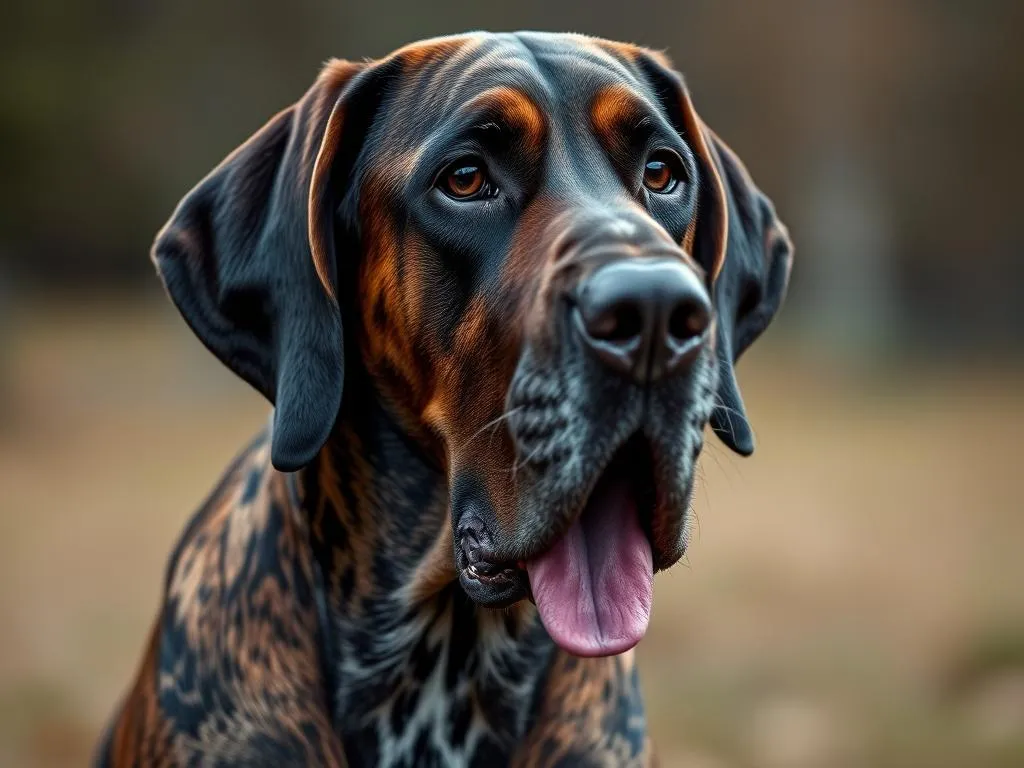
Introduction
In the world of dog breeds, hybrid varieties are becoming increasingly popular. Among these unique mixes, the Bloodhound Great Dane mix stands out for its intriguing combination of characteristics from two distinct breeds. This article aims to provide a comprehensive guide to understanding this delightful mix, featuring insights into its parent breeds, behavioral traits, health considerations, and care requirements.
The Bloodhound is famously known for its incredible sense of smell and friendly nature, while the Great Dane is often referred to as the “gentle giant,” known for its impressive stature and affectionate demeanor. Understanding these breeds is crucial for potential owners who are considering bringing a Bloodhound Great Dane mix into their lives. Throughout this article, readers will gain valuable knowledge about the mix, including its traits, care requirements, and how to ensure a happy, healthy life for their pet.
Understanding the Parent Breeds
Bloodhound
The Bloodhound boasts a rich history, tracing its origins back to medieval Europe, where it was initially bred for tracking game. Renowned for its extraordinary sense of smell, the Bloodhound has played an essential role in search-and-rescue missions and police work.
Physically, Bloodhounds are characterized by their loose, wrinkled skin, long ears, and droopy eyes, giving them a distinctive and lovable appearance. Adult bloodhounds typically weigh between 80 to 110 pounds and stand around 23 to 27 inches tall at the shoulder.
When it comes to temperament, Bloodhounds are known for their friendly, affectionate nature. They are great with children and often get along well with other pets. However, their strong tracking instincts can lead them to follow scents, making consistent training essential. Common health issues for Bloodhounds include hip dysplasia, ear infections due to their droopy ears, and certain hereditary conditions.
Great Dane
The Great Dane, known for its monumental size, has a history that dates back to ancient times. Initially bred for hunting large game, this breed has evolved into a loyal companion known for its gentle disposition.
Great Danes can weigh between 110 to 175 pounds and stand up to 34 inches tall, making them one of the tallest dog breeds. Their sleek, muscular build and elegant stature contribute to their regal appearance.
In terms of temperament, Great Danes are known for their calm and friendly nature. They are typically good with children and can be very protective of their families. However, they can also exhibit some stubbornness, so early training and socialization are crucial. Common health issues include bloat (gastric torsion), hip dysplasia, and heart disease.
The Bloodhound Great Dane Mix: An Overview
Characteristics of the Mix
The Bloodhound Great Dane mix inherits a blend of traits from both parent breeds, resulting in a unique and engaging dog. This mix can weigh anywhere from 85 to 140 pounds and may stand between 24 to 32 inches tall at the shoulder, depending on the genetic influence of each parent.
In terms of appearance, the mix can feature the sleek coat of a Great Dane combined with the droopy ears and wrinkled skin of a Bloodhound. Coat colors may vary, including shades of fawn, brindle, black, or even a combination of these.
Temperament-wise, this mix tends to be friendly, loyal, and sociable, often exhibiting the playful nature of both breeds. However, potential owners should be prepared for a dog that requires consistent training and socialization to manage its strong instincts and energy levels.
Health Considerations
Like all mixed breeds, the Bloodhound Great Dane mix may inherit health issues from both parent breeds. Potential concerns include hip dysplasia, bloat, and ear infections. Regular veterinary check-ups and a good diet are essential to monitor and maintain their health.
Genetic predispositions can play a significant role in the health of your dog, making it crucial to understand the specific conditions associated with Bloodhounds and Great Danes. Being proactive about your dog’s health can help mitigate potential issues and extend their lifespan.
Ideal Living Conditions
Space Requirements
When considering a Bloodhound Great Dane mix, it’s essential to evaluate your living environment. These dogs require ample space to move around comfortably. A house with a yard is ideal, as they enjoy outdoor play and exercise. While they can adapt to apartment living, it is crucial to ensure they receive plenty of exercise daily.
A well-fenced yard is also a significant advantage, as both breeds are known for their strong tracking instincts. This ensures that they can roam safely without the risk of escaping.
Climate Adaptability
The Bloodhound Great Dane mix can adapt to various climates, but it is crucial to monitor their comfort levels, especially in extreme weather conditions. In hot climates, ensure they have access to shade and water, as both parent breeds can be sensitive to heat. Conversely, in colder climates, proper shelter and warmth are necessary to keep them comfortable.
Tips for keeping your dog comfortable include providing a cozy bed, avoiding prolonged outdoor exposure in extreme temperatures, and ensuring access to fresh water at all times.
Training and Socialization
Training Techniques
Training a Bloodhound Great Dane mix requires a patient and consistent approach. Positive reinforcement methods work best, as both breeds respond well to praise and rewards. Early training and socialization are vital, as this mix can inherit stubbornness from the Great Dane and a strong independent streak from the Bloodhound.
Begin with basic obedience commands such as sit, stay, and come. Leash training is also critical, especially given the mix’s size and strength. Enrolling in puppy classes can provide socialization opportunities while teaching essential skills.
Behavioral Traits to Watch For
While the Bloodhound Great Dane mix is generally friendly and affectionate, certain behavioral challenges may arise. For example, their strong prey drive may lead them to chase smaller animals. Monitoring their interactions with other pets and training them to respond to commands can help manage this behavior.
Common behaviors to watch for include excessive barking, stubbornness, or separation anxiety. Addressing these traits early on through proper training and socialization will lead to a well-adjusted and happy dog.
Exercise and Activity Needs
Daily Exercise Requirements
The Bloodhound Great Dane mix is an active breed that requires daily exercise to stay healthy and happy. Aim for at least 60 to 90 minutes of exercise each day, which can include walks, playtime in the yard, and trips to the dog park.
Incorporating mental stimulation into their exercise routine is also essential. Activities like puzzle toys, scent games, or agility training can keep their minds engaged and alleviate boredom.
Fun Activities to Engage Your Dog
To foster a strong bond with your Bloodhound Great Dane mix, engaging in fun activities is crucial. Here are some ideas:
- Fetch: A classic game that allows your dog to run and retrieve.
- Hide-and-seek: Hide treats around the house or yard for your dog to find.
- Obstacle courses: Set up a simple course using household items to challenge your dog physically and mentally.
- Social outings: Visits to dog parks or pet-friendly events can provide social interaction and mental stimulation.
Nutrition and Diet
Dietary Needs
A well-balanced diet is essential for the Bloodhound Great Dane mix to support its growth and energy levels. Look for high-quality dog food that lists meat as the primary ingredient and is formulated for large breeds. Grain-free options may also be beneficial, especially if your dog has food sensitivities.
Feeding Guidelines
Feeding guidelines will vary based on your dog’s age, weight, and activity level. Generally, adult Bloodhound Great Dane mixes may require 3 to 5 cups of food per day, divided into two meals to prevent bloat, a common issue in larger breeds.
Monitoring your dog’s weight and adjusting portion sizes accordingly is crucial. Regular check-ups with your veterinarian can also help ensure your dog maintains a healthy weight throughout its life.
Grooming and Maintenance
Grooming Needs
The Bloodhound Great Dane mix typically has a short coat that requires minimal grooming. Regular brushing once a week can help reduce shedding and keep your dog’s coat healthy. Bathing should be done as needed, depending on how active your dog is and its exposure to dirt or odors.
Don’t forget to check and clean their ears regularly to prevent infections, especially given the Bloodhound’s droopy ears.
Regular Health Checks
Regular veterinary visits are crucial for maintaining the health of your Bloodhound Great Dane mix. Routine check-ups can help catch potential issues early, especially those related to the specific health concerns of both breeds. Monitoring for signs of hip dysplasia, bloat, and other breed-specific conditions is essential for your dog’s well-being.
Life Expectancy and Adoption Considerations
Lifespan of the Mix
The average lifespan of a Bloodhound Great Dane mix ranges from 8 to 12 years, depending on various factors such as genetics, health care, diet, and exercise. Regular veterinary care and a healthy lifestyle can contribute to a longer and happier life.
Adoption vs. Buying
When considering a Bloodhound Great Dane mix, potential owners should weigh the pros and cons of adopting versus buying. Adoption can provide a loving home to a dog in need, while purchasing from a reputable breeder allows for more information about the dog’s lineage and potential health issues.
Regardless of the path you choose, ensure that the source is reputable and prioritizes the health and well-being of their dogs.
Conclusion
In summary, the Bloodhound Great Dane mix is a unique and affectionate hybrid that combines the best traits of both parent breeds. With proper care, training, and socialization, this mix can be a wonderful addition to any family. Understanding the specific needs of this mix, including its health considerations and exercise requirements, will help ensure a happy and fulfilling life together.
As you consider welcoming a Bloodhound Great Dane mix into your home, take the time to research and prepare for the responsibilities that come with dog ownership. This mix can offer boundless love and companionship, enriching your life in countless ways.









